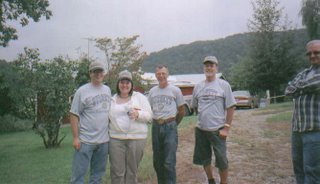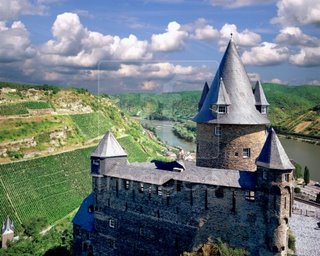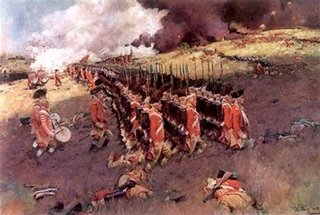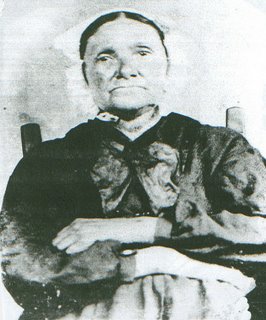 by David Parmer
by David ParmerIn the evening, after the final meal was finished and the quiet time had come,
Doc Ordy would take his favorite seat by the fireplace in the small cottage near the mouth of Road Run, with grandchildren gathered around, and his wife
Effie half-listening, and start telling his stories. Once, Doc Ordy was called to look after an animal late on a winter evening, too far from home, and too cold to start for home. The farmer told Doc that he should stay the night, an invitation he gladly accepted and the farmer showed him to his bed for the night. These were the days before electricity in the hollows around Orlando. To be prepared for the dark, Doc Ordy always traveled with a lantern to light the way home. When he spent the night at a farmer’s home, Doc always took his lantern inside so he could see when he arose early to either check on the sick animal, or to start out for home. This night, as usual, he had his lantern with him when he got into the comfortable looking bed which was to be his resting spot for the night. After rooting into the straw tick bedding, and closing his eyes Doc started drifting off to sleep, but began sen
sing he was not alone in the bed. As he lay still, he could feel unwanted movement all over his body. Doc reached for his lantern and safety matches and quickly had light to unveil the problem. Bedbugs! Hundreds of bedbugs scattered for cover from the glare of the lantern. Thinking for a moment, Doc pulled his large pocket knife from his trousers pocket and jammed it into the wooden headboard of the bed. He hung his lit lantern on his knife handle to provide a constant light and irritant to the bed bugs and he fell asleep soundly until the next morning. His grandchildren loved his teeth-grinding stories, and Doc Ordy loved to tell them.
Ord Conrad was born in 1881 and grew up on Riffle Run, the son of
John B. and
Mary Ann (
Riffle)
Conrad. Ord’s paternal grandfather was also named
John B. Conrad. He was a brother of
Phoebe (
Conrad)
Skinner, wife of
Alexander Skinner of Orlando. Ord’s maternal grandfather was
Jacob Isaac Riffle, one of the original settlers of Clover Fork.
By the way the crow flies, Riffle Run is a very short distance from Orlando. The usual route to Riffle Run from Orlando was either to go up to the head of Road Run and then over the hill to the head of Riffle Run, or go up Clover Fork to the first branch on the right, go to its head and over the hill to Riffle Run. By either route, it was but a short distance to Riffle Run from Orlando, and there was much contact between the two places. Ord Conrad had lived in both Orlando and on Riffle Run and felt quite at home in either place.
Mina Strader and her brother
Richard Strader, grandchildren of Ord’s sister
Mina, tell us that their Uncle Ord learned his veterinary skills from his father
John B. Conrad and his grandfather
John B. Conrad, both of whom had worked with animals during their lifetimes. Ord Conrad started early in life, perhaps at 16 or 17, according to Richard Strader, working with animals by learning the art of castration or "cutting" animals. In those early times, there were no licensing requirements to become an animal doctor. If you could show proficiency in the task in treating sick animals you became known as "Doc" and were called upon to practice the craft. Subsequently when West Virginia instituted licensing and formal schooling of veterinarians, the already practicing veterinarians were "grandfathered in", and simply had to take and pass a written test
1. The veteran Doc Ordy had no trouble in passing the written test and b

ecame "official" in the eyes of the State.
At the e top, left, is Ord with his horse Rex.Immediately to the right and at the bottom left are photos of Effie and Ord.Dixie McCauley, Ord’s grandson, of Mason , West Virginia, doubts that his grandfather had any more than an eighth grade education and probably not even that much. This was not unusual for rural West Virginia before the turn of the 20th century when little weight was given to more than just rudimentary book learning. As was the custom of the time, skills were generally learned on the job, which was as good way to learn as any other way.
Dale Barnett’s father,
Bill Barnett of Orlando, was a livestock farmer and owned several sheep, cows, and horses. From time to time a sheep or larger animal became sick or off its feed and the services of Dr. Ordy were called upon. Dale recalls that Doc was always prompt to answer a call for help. Dale recalls a "spring tonic" for horses that Doc would bring on his calls which reportedly had arsenic as one of the ingredients. Dale recalls that this tonic would be mixed with a little bran in a short necked beer bottle. The out-of-sorts horse would be dosed with the mixture and immediately would "pick right up" and eat everything in sight. One common digestive malady of animals was referred to by Doc as "compaction" or "blockage of the bowels" which seemed to always call for a "good dose of salts." Dale recalls that Doc was fairly successful in treating sick livestock.
Lane Conrad of Martinez , Georgia , Doc’s grandson, recalls that his grandfather would treat a hoof ailment of large animals known as "foot evil". This condition called for dousing a burlap cloth in turpentine and cleaning the animals hooves thoroughly, crevices and all. Lane also recalls that his grandfather would advertise where he would be on certain days and that he would provide rabies shots to neighborhood dogs. In the early 20th century it was common for every farmer to have a number of dogs, not only for bringing in the sheep or cattle but also for chasing the foxes, coons, rabbits, and groundhogs. Doc was prepared to treat dogs as well as the larger beasts.
Bertha Conrad Ratcliff of Stouts Mill, daughter of Doc’s sister
Ann, recalls that Doc treated many a cow for "milk fever". According to Bertha, cows develop a fever when a calf takes too much milk from its mother, causing the milk sack to collapse. Bertha believes her uncle Doc Ordy never lost a cow to the "milk fever." Bertha also recalls her uncle carrying with him a black hose which was used to stick into a cow’s throat to dislodge apples which may be stuck there. This hose also was used to "drench" a cow or horse or other animal when it was necessary to give the animal a "tonic". Bertha thought the tonic was a "drenkstum", based upon her recollection as to what uncle Doc told her he was going to do to the animal. Probably what Doc actually said was that he was going to "drench ‘um’ ".
Bertha (
Conrad)
Ratcliff or
Mina (
Strader)
Luzader, Doc’s nieces, would often be called upon from time to time to stay all night with their Aunt Effie whenever Doc was called out late at night and would not return that night. They both adored their Aunt Effie and were always glad to be called upon to keep her company. And, they also got to help their Aunt Effie can tomatoes, green beans and other garden produce. Bertha recalls that the overnight stays would often be the result of when Doc was treating an animal for the "colic" which Bertha indicated called for a constant walking of the animal throughout the night.
One animal Doc was not fond of was a male hog. Doc’s granddaughter,
Delores (
McCauley)
Hutzel, recalls Doc telling her that boars were generally mean and would attack without warning. Doc said that great care should be taken dealing with this animal and to never turn your back on it. Delores recalls going on a call with her grandfather on one occasion and being chased by a vicious hog. She said her grandfather got a good laugh watching her run for the fence.
 To the right is Ord & Effie's family. Front row: Everett (killed during WW II), Effie and Ord, Minnie (McCauley), Ercie (Barrett). Back row: Ray, Dale, Ern, Earl, and Emmett.
To the right is Ord & Effie's family. Front row: Everett (killed during WW II), Effie and Ord, Minnie (McCauley), Ercie (Barrett). Back row: Ray, Dale, Ern, Earl, and Emmett.
Lane Conrad recalls that Doc had a sorrel horse with a white blaze which he rode on many of his veterinary visits. He believed that Doc called this horse "Fred". However, Lane’s cousin,
Delores McCauley Hutzel, recalls the name of the horse to be "Rex".
Richard Strader, Doc’s nephew, a little older than Lane and Delores, resolved the factual dispute by telling us that in his memory Doc had three horses, "
Rex", "
Bob", and "
Fred".
Mina (
Strader)
Luzader also reports on her Uncle Ord’s keen eyesight. Once Mina was driving her boy friend’s (later to be her husband) car on the old Roanoke road when who should she meet coming the other way but her Uncle Doc. Of course Mina did not have a driver’s license or learner’s permit at the time. By the time she returned home, Mina’s mother was aware that she had been doing a little unauthorized practice driving.
As to what Doc Ordy would charge for a visit to a farmer to treat an animal, Mina Strader Luzader tells us that Doc adjusted his fee according to the circumstances of the farmer. Although his usual fee was a real bargain as far as veterinarians go, if a farmer could not afford to pay but a pittance, that was what

Doc charged.
Mina also recalls that her Uncle Doc was a very clean and neat person who would often wear two pairs of trousers and a working coat out on a call. As we know, working in barns can be a dirty
proposition. Doc would wear the second pair of trousers so that he could take the dirty pair off before going into the farmer’s house. Doc would also go to the creek to wash his dirty boots.
Mina remembers that her brother Richard Strader and Doc went on a call to a farmer’s home on one occasion and was asked to stay for a meal. Seeing that the house was full of dogs and cats which had free roam of the house and dining table, Doc thanked the farmer and said they were in a hurry to see another person about a sick animal and would have to take a rain check. And, speaking of eating, Mina recalls a peculiar breakfast meal which her uncle Ord enjoyed: oatmeal with Oreo cookies! Now there’s a way to start a day!
Richard Strader relates that his uncle went far and wide to treat sick animals. He recalls one trip he made with his uncle that required driving the truck to
Green Hill, east of
Falls Mill, where they were met by the farmer with horse and wagon. They finally got to the farmer’s sick animal on his farm near the present Braxton County airport. Doc regularly went to places like
Rocky Fork,
Indian Fork, Knawl, Sand Fork, Copen and many other remote areas of
Braxton, Lewis and
Gilmer Counties.
As an integral part of dealing with animals, it is obviously necessary to restrain them. Doc reportedly was an expert in lassoing animals and tying them up so they could be treated. Doc carried his lasso on his horse along with his saddle bags full of equipment and tonics for the animals he treated. The potions and tonics carried by Doc were contained in brown bottles of every description. The basement of Doc’s last residence on the river above Burnsville at the time of his death was full of liquids in large brown bottles. The smaller brown dosing bottles were also in plentiful supply. Of course no one but Doc knew what was in the bottles and his pharmaceutical supply was carefully disposed after his death.
Although not a medical doctor, Doc Ordy from time to time was called upon to treat ailments within the family. Doc’s granddaughter,
Delores, recalls that whenever she or her siblings would take ill, her grandfather would be called upon the make the diagnosis and administer the treatment. These ministrations were never without success. Delores also relates that prior to the requirement of embalming, her grandfather was also called upon to prepare corpses for burial from time to time. This line of work was good grist for late at night stories and led to many a spine tingling tale which he loved to tell.
It is further reported that Doc Ordy was a fan of the country music Carter family and owned every record that the family put out. Doc was also an avid reader and a good writer. He had a remarkable memory for family histories and could recite a person’s lineage without difficulty.
There came a time when Doc retired his horses which he had used for years as his primary means of transportation. Of course in the early years, horses were the most reliable means of transportation in the hills and hollows in the area of his work. Paved roads were unheard of in those times, and trails up hollows or paths over ridges were the norm. In his later years, Doc acceded to "modern times" and bought a green Chevrolet pick up truck. Of course driving a truck was not as easy as steering a horse. According to his daughter-in-law,
Mrs. Ray Conrad, Doc did not have a very good reputation as a driver. Instead Doc seemed to "herd" his pickup truck and "everyone knew to keep out of his way". Mina Strader Luzader relates that Doc Ordy got his drivers license by sending a form and twenty five cents to the State of West Virginia. No driving test was required.
Despite any difficulties he may have had in operating a vehicle, it cannot however be said that Doc was not nimble with his fingers. Apparently, Doc favored the "old style" and ate with a knife rather than a fork. His daughter-in-law,
Mrs. Ray Conrad, recalls that he was very adept at eating peas, or any other small vegetables with a knife.
Few farmers who owned livestock around Orlando in the early days could do without a vet to keep the animals healthy, or to treat the injured. Doc Ordy was one of the few veterinarians available to assist in this regard, and proved to be successful and reliable to his neighbors in their need.
Doc died in 1960 and was buried in the hilltop cemetery at Olive Chapel Church above Burnsville . He was survived by his wife Effie, his sons
Ern, Dale, Ray, Emmett and
Earl and his daughters
Ercie and
Minnie. Effie passed away in 1971.
1. The State of West Virginia instituted a requirement that veterinarians be licensed in 1915. There was a provision in the newly enacted law that veterinarians who had been practicing for at least two years prior to the new law could continue to practice veterinary medicine by registering and providing an affidavit of his previous experience. Comments  comment 1 Dale BarnettWhen Doc Ordy was listening to someone he had a peculiar mannerism of throwing his head back and squinting at the speaker with one eye. Dale Barnett (pictured to the right) grew up in Orlando in the 1940s and 50s. He is a retired teacher. His remembrances are part of several entries. For example, see the Feb '07
comment 1 Dale BarnettWhen Doc Ordy was listening to someone he had a peculiar mannerism of throwing his head back and squinting at the speaker with one eye. Dale Barnett (pictured to the right) grew up in Orlando in the 1940s and 50s. He is a retired teacher. His remembrances are part of several entries. For example, see the Feb '07
entry A History of Orlando
comment 2 Homer Heater, Jr.What a delightful story of Doc Ordy. I remember him when I was a child on Riffle Run. Where it came from I don’t know, but we used to have a ditty that said,Hi O Silver everywhere Effie lost her underwear
Effie said, I don’t care, Ordy’ll buy me a streamlined pair Thanks for the memories.
Homer Note: The Rev. Dr. Homer Heater, Jr. who grew up on Riffle Run, is President Emeritus, Washington Bible College/Capital Bible Seminary and Professor of Old Testament, Capital Bible Seminary. See his wonderful Riffle Run memoirs at http://www.geocities.com/hheater2000/RiffleRun.html
Note: The Rev. Dr. Homer Heater, Jr. who grew up on Riffle Run, is President Emeritus, Washington Bible College/Capital Bible Seminary and Professor of Old Testament, Capital Bible Seminary. See his wonderful Riffle Run memoirs at http://www.geocities.com/hheater2000/RiffleRun.html
comment 3: Bill Beckner  I remember old Ord's favorite fix for animals was molasses. Our cow foundered herself on apples. Grandpap had Ord come to take a look and sure enough, he said to feed the cow molasses.
I remember old Ord's favorite fix for animals was molasses. Our cow foundered herself on apples. Grandpap had Ord come to take a look and sure enough, he said to feed the cow molasses.
 by Barbara Hamilton
by Barbara Hamilton with Benjamin when Benjamin died I feel he is probably buried in the same place. I spent years trying to find where this family is buried. Now I have three stories and with them I'm satisified that I know. I would like to share this information.
with Benjamin when Benjamin died I feel he is probably buried in the same place. I spent years trying to find where this family is buried. Now I have three stories and with them I'm satisified that I know. I would like to share this information. First, my husband and I went to Bulltown to camp for several years. A historian worked in the museum at the campground and asked older folks questions regarding where Benjamin might have been buried. He finally ask one elderly man who made him promise not to tell me. The old man said Benjamin was buried on goverment property and if they knew it they would move him, but he was out of the water and they didn't need to know where he was. The day he was buried they carried him across the Iron Bridge on the Napier-Burnsville Road and up the side of that hill, having quite a time to get him up there. Since today I would need a boat to get across the water I never suceeded in getting there.
First, my husband and I went to Bulltown to camp for several years. A historian worked in the museum at the campground and asked older folks questions regarding where Benjamin might have been buried. He finally ask one elderly man who made him promise not to tell me. The old man said Benjamin was buried on goverment property and if they knew it they would move him, but he was out of the water and they didn't need to know where he was. The day he was buried they carried him across the Iron Bridge on the Napier-Burnsville Road and up the side of that hill, having quite a time to get him up there. Since today I would need a boat to get across the water I never suceeded in getting there.![]() A few of the untold number of Conrad descendents in the Oil Creek area: Fibi (Conrad) Skinner (Daniel Conrad's daughter), Robert Lee Mitchell (Benjamin Conrad's 2-great grandson), Juanita (Stutler) Burgett (Daniel Conrad's 4-great granddaughter), Ord Conrad (great-grandson of both Daniel and Benjamin Conrad)
A few of the untold number of Conrad descendents in the Oil Creek area: Fibi (Conrad) Skinner (Daniel Conrad's daughter), Robert Lee Mitchell (Benjamin Conrad's 2-great grandson), Juanita (Stutler) Burgett (Daniel Conrad's 4-great granddaughter), Ord Conrad (great-grandson of both Daniel and Benjamin Conrad) , Genevieve (Skinner) Heater, (2-great granddaughter of Daniel Conrad), Earse Posey (2-greatgrandson of Daniel Conrad).
, Genevieve (Skinner) Heater, (2-great granddaughter of Daniel Conrad), Earse Posey (2-greatgrandson of Daniel Conrad). 


















